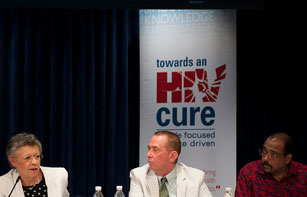
Press Release
Inaugural Global Scientific Strategy Towards an HIV Cure launched ahead of the XIX International AIDS Conference in Washington DC
19 July 2012 19 July 2012World´s leading HIV/AIDS Scientists and Stakeholders to gather in Washington D.C. to discuss Global Alliance on HIV Cure research

L to R: Françoise Barré-Sinoussi, the co-discoverer of HIV, Director of the Regulation of Retroviral Infections Unit at the Institut Pasteur in Paris and the IAS President-Elect; Mark Harrington, Executive Director of the Foundation for AIDS Research; and UNAIDS Executive Director, Michel Sidibé
Thursday, 19 July, 2012 (Washington D.C, US)--The Inaugural Global Scientific Strategy Towards an HIV Cure was launched today ahead of the XIX International AIDS Conference amid renewed optimism from the world´s leading HIV/AIDS scientists that the future prospects for finding an HIV cure are increasing.
Over the past two years the International AIDS Society (IAS) has convened a group of international experts to develop a roadmap for research towards an HIV cure. Published online in an abridged form tomorrow, Friday July 20, in Nature Reviews Immunology, Towards an HIV Cure identifies seven important priority areas for basic, translational and clinical research and maps out a path for future research collaboration and funding opportunities.(1)
“The strategy is the result of a collaborative effort which has produced a roadmap that will constructively move HIV Cure research forward,” said Françoise Barré-Sinoussi, the co-discoverer of HIV, Director of the Regulation of Retroviral Infections Unit at the Institut Pasteur in Paris and the IAS President-Elect. Barré-Sinoussi, together with Professor Steven Deeks, Professor of Medicine at the University of California, San Francisco, is co-chair of the group of 34 leading HIV scientists and clinicians who have developed the Global Scientific Strategy. Professor Barré-Sinoussi and Professor Deeks state the case for HIV cure research in a commentary piece published today in Nature. (2)
“The science has been telling us for some time now that achieving a cure for HIV infection could be a realistic possibility. The time is right to take the opportunity to try and develop an HIV cure – we might regret never having tried,” concluded Barré-Sinoussi at the D.C. launch.
The vision for the IAS strategy for an HIV cure is very clear: a safe, affordable and scalable cure will improve the health and quality-of-life for those with established infection, reduce the risk of transmission of virus to those not infected, and ultimately allow resources to be shifted to other needs.
"Finding a cure for AIDS is a critical innovation gap," said Michel Sidibé, Executive Director of UNAIDS at the launch in D.C. "A cure will bring new hope to people living with HIV and their loved ones and could end the cycle of stigma and discrimination."Major investments in science have resulted in the worldwide availability of over 20 anti-HIV drugs. When used in combination, these drugs restore health, prolong life and reduce transmission of the virus. HIV-infected individuals who harbour drug-susceptible virus, who have access to antiretroviral drugs, who can tolerate the drug side effects, toxicities, and other complications, and who are able to adhere to therapy can maintain control of HIV infection indefinitely.
Despite these successes, these therapies have limitations. They do not eradicate HIV, requiring people to remain on expensive and potentially toxic drugs for life. They do not fully restore health as patients still experience co-morbidities such as increased cardiovascular disease, bone disorders or cognitive impairment. They are expensive and difficult to deliver to all in need.
Although the cost of delivering antiretroviral drugs to the more than 34 million people now living with HIV has decreased substantially, and the availability of these drugs in resource-poor settings has steadily increased, the costs associated with delivering antiretroviral drugs is overwhelming many organizations and public health systems. Estimates put the cost of the funding response to the HIV/AIDS epidemic by 2015 between US$22-24 billion per year (3) and between US$19-35 billion per year by 2031, with antiretroviral treatment accounting for up to 70 per cent of the total cost of care in the most affected countries. (4)
It is estimated that for every person starting treatment, two are newly infected, a path that is clearly unsustainable.
Given these limitations, there is growing recognition that the search for an HIV Cure is an imperative both in terms of the individual and public health benefits it would provide and also an opportunity to potentially avoid the long-term cumulative costs of ART. (5)
Also, an effective and scalable HIV cure will likely achieve what preventative approaches aim to do, which is to essentially stop transmission of HIV to those who are uninfected and restore the immunological function and normal health to those who are infected (6).
The renewed optimism in the search for an HIV Cure amongst scientists is based on a number of scientific advances that are helping to shed light on why it is that HIV remains persistent.
Scientists have known for some time now that latent HIV reservoirs, where HIV hides and persists, are one of the main barriers to finding a cure. This is precisely why treatment does not eradicate HIV and why, when treatment is stopped, the virus rebounds.
“What we haven’t had until very recently is clear insights into why HIV persists during therapy,” said Steven Deeks, at the launch in Washington, D.C. “Our basic understanding of the mechanisms of HIV persistence in latent reservoirs is far superior than it was a decade ago. We are entering a stage in the epidemic in which we can seriously begin testing drugs that either prevent latency or which force the virus out of its hiding place, make it susceptible to our current drugs.” (7)
Press centre
Download the printable version (PDF)
